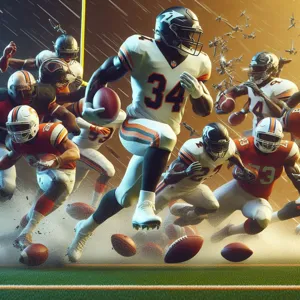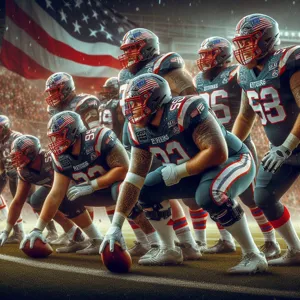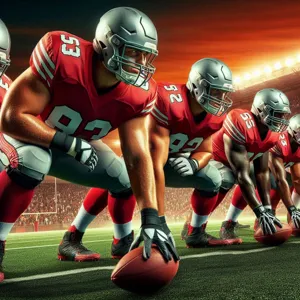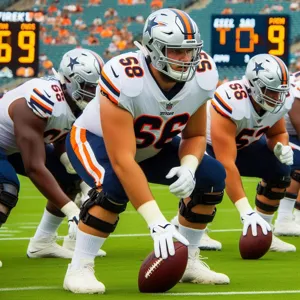American football is a game of strategy, precision, and explosive athleticism, where every play can change the momentum of the game in an instant.
At the heart of this thrilling spectacle lies a complex playbook filled with a multitude of offensive strategies designed to outsmart and outmaneuver opponents. Whether you’re a die-hard fan, a budding player, or just someone looking to understand the game better, diving into the world of offensive plays can provide invaluable insights into what makes football so captivating. In this blog post, we’ll unpack the most common offensive plays in American football, breaking down their formations, purposes, and execution. From the classic power run to the intricate passing schemes, we’ll explore how these plays not only showcase the skill of the players but also the tactical genius of the coaches who orchestrate them. Get ready to elevate your understanding of America’s favorite pastime as we dissect the strategies that lead teams to victory!
1. Introduction to Offensive Plays in Football
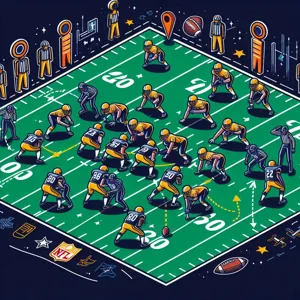
American football is a game of strategy, precision, and execution, where every play can be the difference between victory and defeat. In its essence, offensive plays are the backbone of a team’s ability to score and gain yardage, driving the momentum of the game. These plays are meticulously designed to exploit the weaknesses of the opposing defense, and understanding them is crucial for players, coaches, and fans alike.
At its core, an offensive play begins with a snap from the center, setting into motion a series of coordinated movements by the quarterback, running backs, wide receivers, and offensive linemen. Each position has a specific role, and the interplay between these roles creates a dynamic dance on the field. The quarterback, often seen as the leader of the offense, makes split-second decisions based on the defensive alignment, often relying on both instinct and the game plan laid out by the coaching staff.
Offensive plays can be broadly categorized into several types: running plays, passing plays, and trick plays. Running plays focus on advancing the ball via handoffs to running backs, capitalizing on their speed and agility. Passing plays, on the other hand, involve throwing the ball to receivers who must create separation from their defenders. Trick plays, while less common, can catch defenses off guard, showcasing the creativity and unpredictability that football can offer.
As we delve deeper into the world of offensive plays, we’ll explore the most common strategies and formations that teams utilize. From the classic power run to the intricate spread offense, each play has its distinct purpose and execution, all aimed at outsmarting the opponent and putting points on the board. Understanding these plays not only enhances our appreciation of the game but also provides insight into the tactical minds of the coaches and players who bring this exciting sport to life. Join us as we unpack the playbook and uncover the fundamental offensive plays that define American football.
2. Understanding the Offensive Formation
Understanding the offensive formation is crucial for grasping how teams strategize to penetrate defenses and create scoring opportunities. In American football, an offensive formation is essentially the arrangement of players on the field before the snap. Each formation serves a specific purpose and can dictate the flow of the play, influencing everything from blocking schemes to passing routes.
There are several common formations, each with its own strengths and weaknesses. For instance, the **I-formation**, characterized by a fullback and a tailback lined up behind the quarterback, is known for its power running capabilities. This formation excels in short-yardage situations, allowing the offense to pound the ball effectively between the tackles. Conversely, the **spread formation** spreads out the defense by utilizing multiple wide receivers, creating space for quick passes and running lanes. This is particularly effective for teams that prioritize speed and agility, enabling them to stretch the field vertically and horizontally.
Another popular setup is the **shotgun formation**, where the quarterback stands several yards behind the center. This formation allows for quicker throws and gives the quarterback a better view of the defense, making it easier to assess coverage before the snap. Meanwhile, the **pistol formation** combines elements of both the shotgun and the traditional I-formation, enabling a balanced attack that can switch seamlessly between running and passing plays.
Coaches and players spend countless hours analyzing these formations, tweaking them to exploit defensive tendencies and create mismatches. A well-executed formation not only sets the stage for a successful play but also keeps the defense guessing, making them less likely to predict the offense’s next move. By understanding the nuances of these formations, fans can appreciate the intricate chess match that unfolds on the field, while players can hone their skills to maximize their impact during games. Whether it’s a hard-hitting run or a dazzling touchdown pass, the offensive formation is the foundation upon which the excitement of American football is built.
3. The Importance of the Quarterback in Play Execution
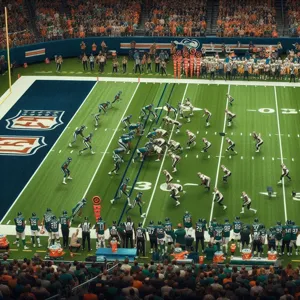
The quarterback, often dubbed the “field general,” plays a pivotal role in the execution of offensive plays in American football. This position is not just about throwing passes; it encompasses leadership, strategy, and quick decision-making under pressure. When the quarterback steps onto the field, he becomes the linchpin around which the entire offensive unit revolves.
First and foremost, the quarterback is responsible for reading the defense. Before the ball is even snapped, he analyzes the opposing team’s formation, looking for vulnerabilities and opportunities. This pre-snap assessment is crucial, as it allows him to make informed decisions about which play to run or whether to audible to a different strategy entirely. The ability to recognize defensive schemes and adjust on the fly can mean the difference between a successful drive and a turnover.
Once the play begins, the quarterback’s role becomes even more critical. He must execute the snap, manage the timing of the play, and effectively communicate with his teammates, ensuring everyone is on the same page. His footwork and pocket presence are vital; he must navigate the chaotic environment of rushing defenders while maintaining his focus on finding the right receiver or making a strategic decision to run the ball himself.
Moreover, the quarterback’s mental fortitude is a significant factor in high-pressure situations. Whether it’s a crucial third down or a game-winning drive, a quarterback must remain composed, often making split-second decisions that can lead to either triumph or defeat. His ability to inspire confidence in his teammates cannot be overstated—when a quarterback exudes calm and control, it uplifts the entire offense, instilling a sense of belief that they can achieve their goals.
In essence, the quarterback’s multifaceted responsibilities make him central to the success of offensive plays. His leadership, tactical awareness, and execution define the rhythm of the game, showcasing why the position is often viewed as one of the most demanding in sports. Whether orchestrating a complex passing play or executing a simple handoff, the quarterback’s influence is felt throughout every offensive series, making him an indispensable component of the team’s strategy.
4. Overview of the Most Common Offensive Plays
When it comes to American football, the offensive playbook is a treasure trove of strategies designed to outsmart the defense and move the ball down the field. Understanding the most common offensive plays is crucial for players, coaches, and fans alike, as it provides insight into the tactical decisions that shape the game. Here, we’ll break down some of the staple plays you’re likely to see on any field.
**1. The Run Play:** Perhaps the simplest and most fundamental offensive play, the run play involves handing the ball off to a running back who attempts to navigate through the defense. This play can take various forms, such as the inside zone, where the running back looks for gaps along the offensive line, or the stretch play, designed to take the runner to the outside. The effectiveness of a run play often hinges on the offensive line’s ability to create space and the running back’s vision and agility.
**2. The Pass Play:** Pass plays are an essential component of any offensive strategy, allowing teams to cover large distances quickly. The quarterback can execute a variety of passes, including short, intermediate, or deep throws, often targeting wide receivers or tight ends. Plays like the slant route, where receivers cut sharply toward the middle of the field, and the go route, where they sprint straight downfield, are common. Timing and precision are critical, as a successful pass play can lead to significant yardage gains.
**3. The Play Action:** This clever strategy is designed to deceive the defense by faking a run play before transitioning to a pass. The quarterback will typically hand the ball off to a running back, prompting defenders to commit to stopping the run. Once the defense bites, the quarterback pulls the ball back and looks for open receivers downfield. The effectiveness of the play action relies heavily on the offensive team’s ability to establish a credible running game earlier in the game.
**4. The Screen Pass:** A screen pass is a strategic play that aims to exploit overzealous defenders. The quarterback quickly throws a short pass to a running back or wide receiver behind the line of scrimmage. Meanwhile, offensive linemen and other players move downfield to set up blocks, creating a wall of protection for the receiver. This play can be particularly effective against aggressive defenses, catching them off-guard and allowing for significant yardage gains.
**5. The Option Play:** In an option play, the quarterback has the choice to either hand the ball off to a running back or keep it themselves, depending on the defensive alignment. This type of play adds an element of unpredictability, as the defense must account for multiple potential ball carriers. The option play requires exceptional decision-making skills from the quarterback and coordination with running backs to maximize its effectiveness.
These offensive plays form the foundation of the game, each with its own strengths and weaknesses. By mastering these strategies, teams can create a dynamic and unpredictable offense that keeps defenders on their toes and sets the stage for thrilling plays and high-scoring games. Whether you’re a player honing your skills or a fan looking to deepen your understanding, familiarizing yourself with these common offensive plays is essential to appreciating the intricacies of American football.
5. The Dive Play: Basics and Strategy

The Dive Play is one of the most fundamental yet effective offensive plays in American football, often serving as the backbone of a team’s rushing attack. At its core, the Dive Play is designed to gain short, consistent yardage by sending the ball directly up the middle of the field, relying on the offensive line’s strength and precision to create a pathway through the defensive front.
### Basics of the Dive Play
In its simplest form, the Dive Play involves the quarterback handing off the ball to a running back, who then charges straight ahead toward the line of scrimmage. The play typically targets the A gaps—the spaces between the center and the guards—where the offensive line attempts to overpower the defenders. This straightforward approach is particularly effective in short-yardage situations or on crucial downs like third and one, where gaining a few yards can make all the difference.
### Strategy Behind the Dive Play
The effectiveness of the Dive Play lies in its ability to exploit defensive weaknesses. By focusing on a direct path up the middle, the offense can catch the defense off guard, particularly if they are expecting more elaborate plays or outside runs. The success of the Dive Play hinges on several key factors:
1. **Offensive Line Play:** The linemen must have a solid understanding of their blocking assignments, working in unison to create a surge at the point of attack. Good technique and communication are critical, as they need to identify defensive alignments and adjust their blocking schemes accordingly.
2. **Running Back Vision:** A running back executing a Dive Play must possess excellent vision and decisiveness. They need to read the blocks and make quick decisions on where to cut, often needing to navigate through a crowded line of scrimmage. The ability to identify the smallest openings can turn a modest gain into a significant one.
3. **Physicality:** The Dive Play thrives in physical matchups. Teams that can impose their will and dominate at the line of scrimmage are more likely to find success with this play. It’s not just about speed; it’s about strength and determination.
4. **Defensive Alignment:** Understanding how the defense is set up is crucial for the offense. If the defense is overcommitted to the outside or has a weak interior line, the Dive Play can exploit those gaps for significant gains.
In conclusion, while the Dive Play may seem simple on the surface, its execution requires a harmonious blend of teamwork, strategy, and physical prowess. By keeping defenses honest and creating a reliable option for short-yardage situations, the Dive Play remains a staple in the playbooks of teams at all levels of football. As coaches often say, mastering the basics can lead to success on the field, and the Dive Play exemplifies this philosophy perfectly.
6. The Sweep Play: Techniques and Variations
The sweep play is a dynamic and versatile offensive maneuver that emphasizes speed and agility, making it a fan favorite on the gridiron. At its core, the sweep play is designed to stretch the defense horizontally across the field, exploiting gaps and creating opportunities for quick gains. This play typically involves a running back or wide receiver taking the handoff and sprinting toward the outside edge, often with the assistance of key blockers from the offensive line and possibly even tight ends or fullbacks. By targeting the perimeter, the offense can capitalize on mismatches against slower linebackers or defensive backs who may be out of position.
Techniques for executing the sweep play hinge on precise timing and coordination. The offensive line must execute a series of blocks, often utilizing a technique known as “pulling.” This involves offensive linemen stepping away from their initial positions to lead the way for the ball carrier, creating a wall of support that can fend off defenders. Effective communication is crucial here, as linemen need to anticipate their movements and make split-second decisions based on the defensive alignment.
Variations of the sweep play add to its effectiveness and unpredictability. One popular variation is the “jet sweep,” where a player in motion, often a wide receiver, receives the handoff while moving at full speed. This not only keeps the defense guessing but also allows for a quicker attack on the edge. Another adaptation is the “counter sweep,” which feigns an attack in one direction before sending the ball carrier back to the opposite side, creating confusion among defenders and opening up lanes for a potential big gain.
Coaches may also implement the sweep play in conjunction with play-action passes, luring defenders toward the run before exploiting the vacated space with a well-timed pass. This blend of run and pass plays keeps defenses on their toes, making it essential for them to remain disciplined in their assignments.
In essence, the sweep play is a testament to the blend of strategy, speed, and teamwork inherent in American football. When executed correctly, it not only advances the ball but also sets the stage for further offensive opportunities, ensuring that defenses are constantly challenged to adapt to the ever-evolving game plan.
7. The Pass Play: Types and Execution
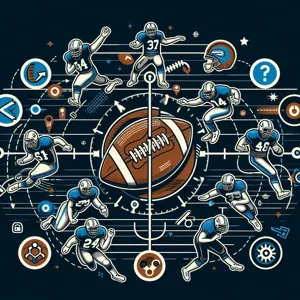
The pass play is a cornerstone of American football, embodying strategy, precision, and teamwork. Unlike running plays, where the focus is primarily on gaining yards through physical strength and speed, pass plays open up a dynamic and multifaceted aspect of the game, transforming the field into a chessboard where each move can dramatically alter the outcome of a drive.
### Types of Pass Plays
Pass plays can be broadly categorized into several types, each with its own unique approach and execution style:
1. **Short Passes**: These plays typically involve quick throws to receivers positioned close to the line of scrimmage. Common routes include slants, screens, and quick outs. The goal is to gain modest yardage while minimizing risk, often relying on the receiver’s ability to make defenders miss after the catch.
2. **Medium Passes**: These plays target receivers running routes that stretch the field a bit more, such as curls, digs, or crosses. The quarterback aims to exploit soft spots in the defense, often taking advantage of mismatches or zones where defenders may be spread thin.
3. **Deep Passes**: As the name suggests, these plays involve throwing the ball downfield to receivers running longer routes, like go routes or post routes. Deep passes require precision timing and a strong arm, as they aim to capitalize on larger chunks of yardage and potentially set up scoring opportunities.
4. **Play Action Passes**: This type of pass play is designed to deceive the defense into thinking the offense will run the ball. By faking a handoff to a running back, the quarterback draws defenders up to the line of scrimmage, creating space for a receiver downfield. Successful execution hinges on the quarterback’s ability to sell the fake convincingly.
### Execution of the Pass Play
Executing a successful pass play involves a synchronized effort from multiple players on the field. Here’s how it typically unfolds:
– **Quarterback’s Role**: The quarterback is the linchpin of the pass play, responsible for reading the defense, making split-second decisions, and delivering the ball accurately. Pre-snap, the quarterback analyzes the defense’s alignment and adjusts the play if necessary. After the snap, they drop back to create space, scan the field for open receivers, and then release the ball with precision.
– **Receiver Routes**: Each receiver has a designated route to run, which is carefully crafted to exploit defensive weaknesses. Timing is crucial; receivers must break on their routes at the right moment to ensure they’re in the optimal position when the ball arrives. Communication and trust between the quarterback and receivers are key components for success.
– **Offensive Line Protection**: The offensive line plays a vital role in pass protection. They must create a pocket around the quarterback, fending off defensive linemen and blitzers to allow sufficient time for the pass play to develop. Good protection can make the difference between a completed pass and a sack.
As the game evolves, the complexity of pass plays continues to grow, with offensive coordinators constantly devising new strategies to outsmart defenses. Understanding the various types of pass plays and their execution is essential for both players and fans alike, as it unveils the intricate dance of strategy that defines the excitement of American football.
8. The Bootleg Play: Deception and Timing
The Bootleg Play is one of the most clever and effective offensive strategies in American football, combining deception with impeccable timing to outsmart defenses. At its core, the Bootleg involves the quarterback faking a handoff to a running back, drawing defensive players toward the line of scrimmage, before rolling out in the opposite direction. This sudden shift not only disorients defenders but also opens up space for the quarterback to either pass or run the ball themselves.
Timing is critical in executing a successful Bootleg. The offensive line must sell the fake by engaging with defenders, creating the illusion that a running play is unfolding. As the quarterback makes the fake handoff, they need to maintain a keen awareness of the field, quickly assessing where the defensive pressure is coming from. A well-timed Bootleg can catch even the most disciplined defenses off guard, especially if they have been conditioned to expect a conventional play.
The effectiveness of the Bootleg is amplified when it is strategically woven into the fabric of a team’s overall game plan. Teams often use it after establishing a strong running game, making defenders more susceptible to the fake. Additionally, the Bootleg can capitalize on misdirection, exploiting the natural instincts of defenders who react too quickly to the initial play action.
When executed with precision, the Bootleg can lead to big gains, whether through a long pass downfield or a quarterback scramble for crucial yardage. It’s a play that not only showcases the quarterback’s athleticism and decision-making skills but also underscores the importance of deception in football strategy. As the game evolves, mastering the Bootleg can keep defenses guessing and create opportunities for offensive success.
9. The Play Action Pass: Creating Misdirection
The Play Action Pass is a masterclass in deception, an offensive strategy designed to keep defenses guessing and create openings for successful passes downfield. At its core, this play hinges on the ability to sell the run. Quarterbacks, alongside their running backs, execute a convincing handoff, leading defenders to believe a rushing play is in motion. This moment of misdirection is crucial; it forces linebackers and safeties to commit to stopping the run, which opens up space for receivers to exploit in the passing game.
When executed correctly, the Play Action Pass can be a game-changer. As the quarterback feigns the handoff, he maintains a keen awareness of the field. The defense, initially drawn in by the fake, often leaves receivers unattended. This creates prime opportunities for big gains. Receivers, especially those with speed and agility, can take advantage of the momentary confusion, making sharp cuts and finding pockets of space in the secondary.
Moreover, this play can be particularly effective in short-yardage situations where defenses expect a run. By keeping them on their toes, the offense not only enhances its passing game but also builds a psychological advantage over the defense. The threat of the Play Action Pass means defenders must remain disciplined, which can lead to mistakes and mismatches.
In essence, the Play Action Pass exemplifies the beauty of football strategy—where intelligence meets athleticism, and the simplest of fakes can lead to the most significant of plays. Whether it results in a deep throw to a wide-open receiver or a critical first down, this offensive maneuver is a staple in the playbook that keeps fans on the edge of their seats.
10. The Screen Pass: When and How to Use It
The screen pass is an artful play that, when executed correctly, can leave defenses scrambling and open up significant yardage for the offense. This play involves a delicate balance of timing, deception, and athlete agility, making it a favorite among coaches looking to capitalize on aggressive defensive strategies.
Typically, the screen pass is utilized when the defense is employing a heavy pass rush, aiming to overwhelm the quarterback with pressure. By luring defenders into the backfield, the offense creates a perfect opportunity for a well-timed dump-off pass to a running back or wide receiver, who has been strategically positioned behind the line of scrimmage. The key here is to sell the traditional pass play, allowing defenders to commit to rushing before the offensive linemen release and set up a wall of protection.
Timing is critical; the quarterback must be aware of the defensive rush while also delivering the ball with just the right amount of loft to allow the receiver to gather it without losing momentum. Once the ball is caught, the receiver should have a clear path, aided by the offensive linemen, who will shift their focus to blocking defenders that have over-committed to the line.
The screen pass can be effectively employed in various situations: during third downs when short yardage is needed, to exploit mismatches against slower linebackers, or even as a change-of-pace play to keep the defense off-balance. When executed flawlessly, this play not only advances the ball but can also swing the momentum of the game, igniting both the players and the crowd.
In essence, the screen pass is a tactical weapon in the offensive playbook, offering a chance for big gains when the defense least expects it. Mastering this play can significantly elevate a team’s offensive strategy, making it a reliable go-to in critical game situations.
11. The Option Play: Flexibility and Decision-Making
The Option Play is one of the most dynamic and flexible offensive strategies in American football, showcasing the importance of decision-making under pressure. At its core, the Option Play presents the quarterback with a critical choice as the play unfolds—whether to hand the ball off to a running back, keep it for himself, or pitch it to another back trailing behind. This multifaceted approach not only keeps defenders guessing but also requires impeccable timing and instinct from the quarterback.
When executed correctly, the Option Play can exploit defensive weaknesses and create significant yardage gains. As the quarterback approaches the line of scrimmage, he reads the defensive alignment and the movements of key defenders, typically a linebacker or defensive end. If the defender commits to the running back, the quarterback has the green light to keep the ball, using his speed and agility to slice through the defensive line. Conversely, if the defender focuses on the quarterback, the handoff becomes the preferred option, allowing the running back to burst into open space.
One of the most thrilling aspects of the Option Play is its inherent unpredictability. Coaches can tailor the play based on the strengths of their players or the specific weaknesses of the opposing defense. This adaptability makes it a favorite among teams that thrive on misdirection and quick decision-making. However, the success of the Option Play hinges on the chemistry and communication among the players, as each member must be in sync to capitalize on the opportunities presented during the play.
In addition to its strategic advantages, the Option Play also adds an element of excitement for fans. The suspense builds as the quarterback navigates through a sea of defenders, leaving spectators on the edge of their seats, eager to see which choice he will make. Ultimately, the Option Play exemplifies the beauty of American football: a blend of strategy, skill, and the ability to make split-second decisions that can change the course of a game.
12. Red Zone Offense: Strategies for Scoring
The red zone, defined as the area from the opponent’s 20-yard line to the goal line, is where games are often won or lost. Scoring in this crucial territory requires a mix of strategy, precision, and a deep understanding of your team’s strengths and the defense’s weaknesses. Here, we unpack some effective strategies that offensive teams employ to maximize their chances of success when the stakes are highest.
One of the most popular approaches in red zone offense is the use of **power runs**. By leveraging the strength of the offensive line and the running back’s ability to push through defenders, teams can create a physical presence that wears down the defense. This strategy often involves pulling guards or utilizing fullbacks to create optimal blocking angles, making it easier for the running back to find a gap and punch through for a touchdown.
Another effective tactic is the **play-action pass**. This play capitalizes on the defense’s anticipation of a run, often drawing them closer to the line of scrimmage. When executed well, a fake handoff can momentarily freeze linebackers and safeties, allowing a receiver to slip behind the coverage. Quarterbacks need to be adept at selling the fake, while receivers must have precise timing and speed to exploit the resulting space.
**Short and quick passes** are also crucial in the red zone. Given the limited space, quarterbacks often target their most reliable receivers with quick slants, outs, or fades. These routes require precise timing and chemistry between the quarterback and the receiver, as defenders are usually tighter in coverage. Utilizing tight ends and running backs in these situations adds versatility, as they can create mismatches against smaller defensive backs.
Finally, **formation variations** can keep the defense guessing. By shifting players and changing alignments, offensive coordinators can create confusion, leading to mismatches that can be exploited. Utilizing stacked formations or motioning players can provide valuable insights into the defensive setup and create openings for key plays.
In summary, a successful red zone offense hinges on a blend of power running, strategic passing, and clever formations. By carefully crafting their approach in this high-pressure area, teams can significantly improve their chances of scoring and, ultimately, winning games. Whether it’s a last-minute drive or a crucial playoff game, mastering red zone strategies is essential for any offense aiming to make an impact on the field.
13. Analyzing Offensive Plays: Film Study and Game Situations
Analyzing offensive plays through film study is a crucial aspect of understanding the intricacies of American football. Coaches and players alike dedicate countless hours to watching game footage, dissecting every play to uncover patterns, tendencies, and opportunities for improvement. This practice is not merely about observing what happened; it’s about understanding why it happened and how different game situations influence the effectiveness of various plays.
When analyzing film, players focus on several key elements. First, they examine the alignment and formation of both their offense and the opposing defense. Understanding how defenses react to specific formations can provide invaluable insights into what plays are likely to succeed based on the situation at hand. For example, a defense might shift into a zone coverage when they anticipate a passing play, while a blitz might be employed in obvious passing down situations.
In addition to defensive reactions, players also assess their own execution. This includes evaluating footwork, timing, and the precision of routes run by receivers. By breaking down these components, players can identify areas for improvement, ensuring that each individual is not only aware of their responsibilities but also how their actions impact the overall effectiveness of the play.
Game situations further complicate the analysis of offensive plays. Coaches and players must consider factors such as the score, time remaining, field position, and the strengths and weaknesses of both their own team and the opponent. For instance, a high-pressure situation, like being down by a touchdown with only two minutes left in the game, may call for a more aggressive play-calling strategy, emphasizing deep passes and quick plays to maximize time efficiency. Conversely, when leading late in the game, teams may opt for a conservative approach, focusing on ball control and clock management to secure the win.
This multifaceted approach to film study and situational analysis is what sets successful offenses apart. By diligently studying past performances and preparing for various game scenarios, teams can develop a nuanced understanding of their offensive playbook, allowing them to adapt and execute with precision when it matters most. In the ever-evolving landscape of American football, mastering the art of analyzing offensive plays is key to gaining a competitive edge on the field.
14. Adapting Plays to Team Strengths and Weaknesses
In the intricate world of American football, the ability to adapt plays to suit a team’s unique strengths and weaknesses is paramount to achieving success on the field. A single playbook may contain a plethora of strategies and formations, but the true artistry of coaching lies in the meticulous tailoring of these plays to capitalize on the players’ individual skills and the dynamics of the opposing team.
Recognizing your team’s strengths is the first step in this adaptive process. For instance, if you have a powerful offensive line that excels at creating gaps for the running back, you might lean heavily on running plays that emphasize this advantage. Conversely, if your quarterback possesses a strong arm and quick decision-making skills, it makes sense to implement more passing plays that stretch the field and exploit the defense’s weaknesses.
On the flip side, understanding your team’s weaknesses is equally crucial. If your offensive line struggles against strong defensive fronts, it may be wise to incorporate quick-release passes or screens that minimize the time the quarterback spends in the pocket. This strategic adjustment can help mitigate pressure while still keeping the offense productive.
Moreover, adaptability is not merely a one-time adjustment; it requires continual assessment throughout the season. Coaches should closely monitor player performance, injury statuses, and even opponent tendencies, refining their play selection to stay one step ahead. This ongoing evaluation fosters a responsive game plan that evolves as the season progresses, ensuring that the team remains competitive against diverse challenges.
In essence, adapting plays to align with team strengths and weaknesses is an art form that combines keen insight, strategic foresight, and a deep understanding of the game. Teams that master this skill not only enhance their performance but also cultivate a resilient and versatile playing style, allowing them to rise to the occasion when it matters most.
15. Conclusion: The Evolution of Offensive Strategies in Football
As we conclude our exploration of the most common offensive plays in American football, it’s essential to recognize that the game is in a constant state of evolution. The strategies employed on the field have transformed dramatically over the decades, influenced by myriad factors including advances in athletic training, changes in player skill sets, and the ever-evolving understanding of game dynamics.
In the early days of football, the focus was primarily on straightforward, power-based plays, such as the classic dive or sweep. However, as the game matured, so did the complexity of its offensive strategies. Coaches began to innovate, introducing more intricate formations and plays designed to outsmart rather than simply overpower the opposition. The rise of the West Coast offense in the 1980s epitomized this shift, emphasizing short, precise passes and ball control over brute force, setting the stage for today’s fast-paced and dynamic playing style.
Now, we witness a trend toward hybrid offenses that blend traditional elements with modern twists—think of the read-option, where quarterbacks have the freedom to make split-second decisions based on the defense’s alignment. Furthermore, the integration of technology in training and game preparation has allowed teams to analyze their opponents with unprecedented detail, refining their offensive plays to exploit specific weaknesses.
As we look to the future, one can only speculate how offensive strategies will continue to evolve. Will we see further integration of analytics, leading to even more unconventional plays? Will new formations or player positions emerge, challenging our understanding of the game? What remains clear is that the creativity and adaptability of coaches and players will always drive the evolution of offensive football. As fans, we can look forward to witnessing this ongoing transformation, where each season brings fresh strategies, exciting plays, and thrilling moments that will shape the history of the sport.
In conclusion, understanding the most common offensive plays in American football is crucial for both fans and players alike. Whether you’re a seasoned enthusiast or a newcomer to the game, these foundational plays serve as the building blocks of a team’s strategy on the field. By unpacking concepts such as the power run, play-action pass, and the spread offense, you can gain deeper insights into the dynamics of the game and appreciate the tactical decisions made by coaches and players. As you watch your next game, keep an eye out for these plays in action, and you might just find yourself cheering with a new level of understanding and excitement. Thank you for joining us on this journey through the playbook—now, get out there and enjoy the game!


